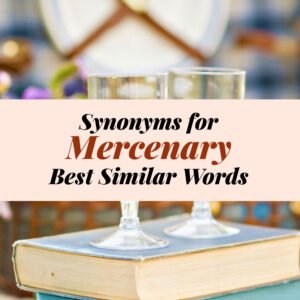When two things come together to form one, we often use the word merge. But there are many other words that can express the same idea. Words like combine, blend, or unite can describe bringing things together in different ways. In this article, you’ll discover 21 powerful synonyms for “merge” with examples and explanations.
| Synonym | Example |
|---|---|
| Combine | The two companies decided to combine their resources for a new project. |
| Unite | The leader’s speech helped unite the people. |
| Join | They will join forces to complete the task. |
| Fuse | The two metals fuse together when heated. |
| Blend | She likes to blend different colors in her art. |
| Integrate | The teacher plans to integrate technology into the classroom. |
| Amalgamate | The firms will amalgamate to form a larger organization. |
| Consolidate | The manager wants to consolidate all the reports into one document. |
| Meld | The artist managed to meld modern and traditional styles. |
| Mix | You need to mix the ingredients carefully. |
| Coalesce | The small groups will coalesce into one big team. |
| Incorporate | The design will incorporate feedback from the users. |
| Converge | All the roads converge at the city center. |
| Affiliate | The smaller branch will affiliate with the main company. |
| Connect | The bridge will connect the two towns. |
| Synthesize | Scientists synthesize new compounds in the lab. |
| Unionize | The workers decided to unionize for better benefits. |
| Absorb | The sponge will absorb all the water. |
| Compound | The chemicals will compound to create a new substance. |
| Alloy | Bronze is an alloy of copper and tin. |
| Intermingle | The cultures intermingle freely in this city. |
21 Different Ways to Say MERGE: Another Word for Merge
1. Combine
The word combine means to bring two or more things together to make something new or stronger. It can be used for objects, ideas, or efforts. You can combine ingredients in cooking, merge data in business, or join talents in teamwork. It is a flexible word that works for daily life and professional situations. Combine shows the idea of cooperation and unity, where two or more things come together but each can still be noticed. It is best when the goal is to make a better result by joining forces.
Examples:
- We should combine our skills to finish this faster.
- The artist likes to combine music with painting.
- Let’s combine our notes before the exam.
- Two small businesses combined to form a bigger one.
2. Unite
Unite is used when people or groups come together for a shared goal or purpose. It emphasizes teamwork, harmony, and strength. Unite often refers to social or emotional situations, such as bringing communities, families, or teams together. It shows that differences are set aside to work as one. You can unite people through activities, speeches, or shared missions. Unite is perfect when you want to stress collective effort and unity rather than just physical combination.
Examples:
- The event helped unite people from different backgrounds.
- The coach’s words united the team before the final match.
- We must unite to solve this problem.
- Music can unite people around the world.
3. Join
Join means to bring two things or groups together or to become part of something larger. It can be physical, like joining paths or hands, or abstract, like joining efforts or organizations. This word is simple and widely used in everyday conversation and formal settings. Join is suitable when you want to emphasize participation and connection. It also shows an action where something becomes part of something else. Using join highlights collaboration and partnership clearly.
Examples:
- Would you like to join our group project?
- Two roads join near the old church.
- Let’s join forces to clean the park.
- She joined the new company last month.
4. Fuse
Fuse means to melt, blend, or join so completely that separate identities disappear. It is often used for metals, materials, or energy but also applies to ideas or feelings. Fuse is a strong word that suggests transformation and unity. You can use it in creative, technical, or emotional contexts. It is best when you want to show that two elements become inseparable or work together seamlessly. Fuse emphasizes strength, integration, and complete unification.
Examples:
- The metals fuse together when heated.
- Their ideas fused into one powerful plan.
- The movie fuses action with deep emotion.
- Technology and art fuse beautifully in this project.
5. Blend
Blend means to mix two or more things so that they come together smoothly. It can describe colors, flavors, materials, or ideas. Blend is useful when each part contributes to the final result without losing its characteristics. It suggests harmony and balance. Use blend when combining things creatively, like music, design, or cooking. Blend is ideal when you want to emphasize mixture, balance, and smooth integration of different elements.
Examples:
- She loves to blend soft colors in her paintings.
- The chef blended spices to make a new flavor.
- Their voices blend perfectly in the song.
- Modern design blends with classic architecture in this home.
6. Integrate
Integrate means to bring parts together so that they work as a complete whole. It is often used in systems, organizations, or communities. Integrate shows that each part is included and contributes to the bigger picture. It works well in professional, educational, and technical contexts. You can integrate software, policies, cultures, or ideas. The word emphasizes organization, unity, and effectiveness by connecting separate elements into one functional unit.
Examples:
- The school plans to integrate art into all subjects.
- The company will integrate new software next week.
- Immigrants often integrate into their new communities.
- She integrates modern ideas into her research.
7. Amalgamate
Amalgamate means to combine or unite two or more entities into a single form. It is commonly used in business or formal contexts. Amalgamate gives the sense of creating a new whole from multiple parts. It is best when combining companies, organizations, or departments. The word emphasizes permanence and thorough combination. Amalgamate is perfect for official processes where elements merge and are no longer separate in function or identity.
Examples:
- The two firms will amalgamate next year.
- Several schools amalgamated to create one large institution.
- The new policy will amalgamate different departments.
- They decided to amalgamate their ideas for the proposal.
8. Consolidate
Consolidate means to combine parts to make them stronger, more organized, or more effective. It is often used in business, finance, or management. Consolidate suggests removing weakness or redundancy while joining resources or efforts. It is ideal when merging information, companies, or positions to strengthen them. The word emphasizes improvement, organization, and unity. Consolidate is best when the goal is efficiency and stability in the merged entity.
Examples:
- We should consolidate all our data in one file.
- The company consolidated its position in the market.
- The teacher consolidated all lessons before the exam.
- They consolidated their offices to reduce costs.
9. Meld
Meld means to combine elements so they form a single, unified entity. It often applies to ideas, styles, or techniques. Meld suggests harmony and creativity in the combination. It is excellent for artistic, professional, or conceptual contexts. Using meld emphasizes the smooth joining of parts where each element adds value. The word conveys a seamless connection that creates something new from existing pieces.
Examples:
- The artist managed to meld modern and traditional styles.
- The flavors meld into a delicious sauce.
- The two ideas meld perfectly in this plan.
- Their skills meld to make a strong team.
10. Mix
Mix means to combine two or more things so that they are together. It is used for physical substances, like ingredients, or abstract things, like ideas or groups. Mix is easy to use in everyday conversation or instructions. It emphasizes the process of bringing things together rather than the final result. Use mix when you want to show combination without complete transformation.
Examples:
- You need to mix the ingredients carefully.
- The teacher mixed students from different classes.
- Their opinions mixed to create a better solution.
- Colors mix beautifully in this painting.
11. Coalesce
Coalesce means to come together and form one group or unit. It is often used for teams, ideas, or small groups combining into something bigger. Coalesce shows growth, unity, and collaboration. It is suitable for formal or professional contexts. Use it when small parts gradually join to form a stronger whole. The word emphasizes the natural or gradual merging process.
Examples:
- The small groups will coalesce into one big team.
- Ideas coalesce during brainstorming sessions.
- Communities coalesce to support a common cause.
- The clouds coalesced before the storm.
12. Incorporate
Incorporate means to include something as part of a whole. It is often used in planning, design, or strategies. Incorporate ensures that each element contributes to the bigger picture. It is ideal when combining feedback, rules, or features into a final plan. The word suggests careful and thoughtful merging. Incorporate emphasizes inclusion, integration, and effectiveness.
Examples:
- The design will incorporate feedback from the users.
- Teachers incorporate new methods into lessons.
- The plan incorporates safety measures.
- We need to incorporate all suggestions before finalizing.
13. Converge
Converge means to come together at a point or to meet. It is used for physical paths, ideas, or people. Converge implies direction and focus toward a single point. It is perfect for traffic, roads, or planning meetings. Converge emphasizes movement, alignment, and reaching a shared objective.
Examples:
- All the roads converge at the city center.
- The teams converged to finalize the project.
- Ideas converge during discussion sessions.
- Streams converge into the river.
14. Affiliate
Affiliate means to connect or associate with a larger organization or group. It is commonly used in business, clubs, or networks. Affiliate shows a formal connection where one part benefits from joining another. Use it when describing partnerships, branches, or associations. It emphasizes cooperation and alignment under a shared identity.
Examples:
- The smaller branch will affiliate with the main company.
- The club affiliates with a national organization.
- The school affiliates with international programs.
- They affiliated with a well-known brand.
15. Connect
Connect means to join or link two or more things. It applies to physical, digital, or abstract connections. Connect emphasizes interaction, communication, and relationship. It is widely used in technology, travel, and social contexts. Using connect highlights the ability to join things while maintaining their function.
Examples:
- The bridge will connect the two towns.
- Wi-Fi connects devices to the internet.
- The manager connects team members to projects.
- Stories connect people across generations.
16. Synthesize
Synthesize means to combine parts to form a coherent whole. It is often used in science, research, or creative work. Synthesize emphasizes thoughtful combination to produce new results or knowledge. It is ideal for combining ideas, materials, or information in a meaningful way. Using synthesize shows intelligence and planning in the merger process.
Examples:
- Scientists synthesize new compounds in the lab.
- The author synthesizes various ideas into a book.
- The teacher synthesizes lessons for better understanding.
- Music can synthesize different styles beautifully.
17. Unionize
Unionize means to form a union or join together for collective benefits. It is mainly used in workplaces and groups advocating for rights. Unionize emphasizes teamwork, protection, and shared goals. It is suitable for legal or professional contexts. Using unionize shows the power of coming together for a strong purpose.
Examples:
- The workers decided to unionize for better benefits.
- Employees unionized to negotiate higher wages.
- Staff unionized to improve working conditions.
- The team unionized to support a common cause.
18. Absorb
Absorb means to take in and include completely. It can be used physically, like a sponge, or abstractly, like ideas or resources. Absorb emphasizes total inclusion and taking over. Use absorb when one element fully takes in or merges with another. It highlights complete integration.
Examples:
- The sponge will absorb all the water.
- The company absorbed smaller competitors.
- Students absorb knowledge from various sources.
- The city absorbed surrounding villages.
19. Compound
Compound means to combine parts to make a new whole, often creating something stronger or more complex. It is used in science, finance, or ideas. Compound emphasizes growth and combination. It is suitable for professional or academic contexts. Using compound shows that the merger leads to a more valuable or impactful result.
Examples:
- The chemicals will compound to create a new substance.
- Interest compounds over time in a bank account.
- The problems compounded after the storm.
- Skills compound to improve performance.
20. Alloy
Alloy means to mix metals or materials to make a stronger substance. It can also describe blending qualities or traits. Alloy emphasizes transformation and improvement through combination. It is ideal for technical or figurative usage. Using alloy shows that merging creates a better, unified product.
Examples:
- Bronze is an alloy of copper and tin.
- The metals alloy to improve strength.
- Different ideas alloy to create innovation.
- The team’s strengths alloy to achieve success.
21. Intermingle
Intermingle means to mix or blend together, often referring to people, cultures, or ideas. It suggests harmony while keeping distinct elements noticeable. Intermingle is suitable for social, cultural, or creative contexts. Using intermingle emphasizes interaction and exchange while forming connections. It shows that different parts coexist and enrich each other when joined.
Examples:
- The cultures intermingle freely in this city.
- Guests intermingle during the party.
- Ideas intermingle in brainstorming sessions.
- The streams intermingle before reaching the lake.

Final Thoughts
Using different synonyms for merge allows you to describe joining, combining, or blending in unique ways. Words like unite, fuse, and integrate help express precise meanings and contexts. Choosing the right synonym makes your writing or speech more accurate and engaging.








